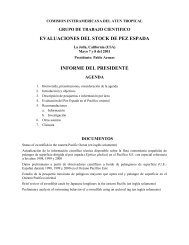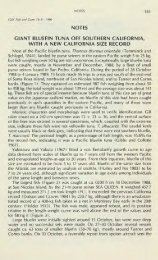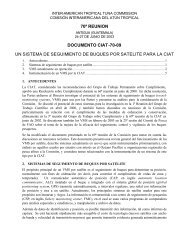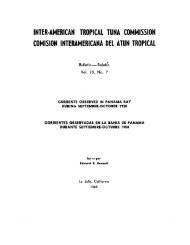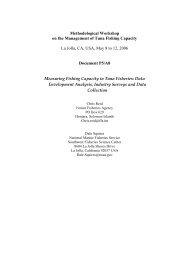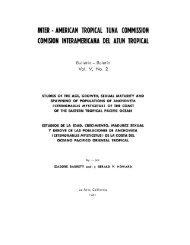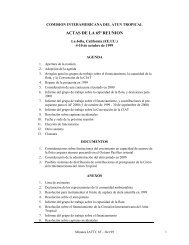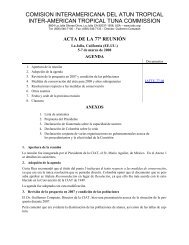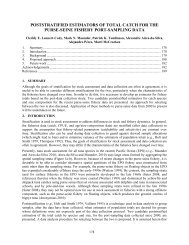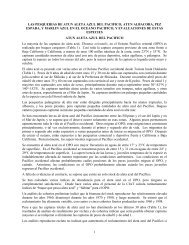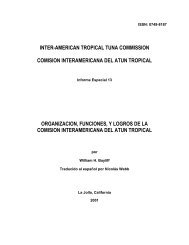Informe Anual de la Comisión Interamericana del Atún Tropical, 19
Informe Anual de la Comisión Interamericana del Atún Tropical, 19
Informe Anual de la Comisión Interamericana del Atún Tropical, 19
You also want an ePaper? Increase the reach of your titles
YUMPU automatically turns print PDFs into web optimized ePapers that Google loves.
ANNUAL REPORT <strong>19</strong>87<br />
stopped fishing this net gain would cause the popu<strong>la</strong>tion to increase gradual1y to its original size. As<br />
the popu<strong>la</strong>tion approached that size the rates of recruitment, growth, andlor natural mortality<br />
would gradual1y approach their previous levels until they were the same as before the fishery began.<br />
The popu<strong>la</strong>tion would thus be restored to equilibrium at its maximum size. If the boats continued to<br />
fish at the same rate, however, the popu<strong>la</strong>tion would eventual1y come into equilibrium with different<br />
rates ofrecruitment, growth, andlor natural mortality and a popu<strong>la</strong>tion size which was lessthan the<br />
original popu<strong>la</strong>tion size. The catch per unit of effort (CPUE) would still be proportional to the<br />
popu<strong>la</strong>tion size. Ifthere were only afew boats the popu<strong>la</strong>tion size would be only slightly reduced and<br />
the CPUE would be re<strong>la</strong>tively high, but if there were many boats the popu<strong>la</strong>tion would be<br />
consi<strong>de</strong>rably reduced and the CPUE would be much lower.<br />
The total catch would be the product ofthe CPUE and the total effort. Ifthe fishing effort were<br />
re<strong>la</strong>tively low, mo<strong>de</strong>st increases in effort would more than offset the corresponding <strong>de</strong>creases in<br />
CPUE, resulting in higher catches, but at higher levels ofeffort such would not be the case. At sorne<br />
intermediate level ofeffort the product would be at its maximum. Ifthe objective ofmanagement is to<br />
obtain the average maximum sustainable yield (AMSY) offish (which is the objective stated in the<br />
IATTC's convention) the fishing effort should be maintained at that level. If the object is maximum<br />
profit the effort should be somewhat less(assumingthat the price remains constant), and ifthe object<br />
is maximum employment offishermen the effort should be somewhat higher. Ifthe effort is less than<br />
whatever optimum is selected, the popu<strong>la</strong>tion is said to be un<strong>de</strong>rfished, and if the effort is greater<br />
than that optimum, the popu<strong>la</strong>tion is said to be overfished.<br />
It is easiest to consi<strong>de</strong>r the interre<strong>la</strong>tionships of effort, catch, and CPUE at equilibrium<br />
conditions, but it must be recognized that such conditions are not always presento For example, ifthe<br />
popu<strong>la</strong>tion is at equilibrium near its maximum and the effort is sud<strong>de</strong>nly increased the CPUE will<br />
gradual1y <strong>de</strong>crease for a period before a new equilibrium point with a lower CPUE is reached. The<br />
catches wil1 be greater during the period oftransition than at the new point ofequilibrium. Likewise,<br />
ifthe popu<strong>la</strong>tion is at equilibrium at a low level and the effort is sud<strong>de</strong>nly <strong>de</strong>creased the CPUE will<br />
gradual1y increase for a period before a new equilibrium point is reached with a higher CPUE. The<br />
catches wil1 be less during the period of transition than at the new point of equilibrium.<br />
It is appropriate at this point to examine the applicability and usefulness of production<br />
mo<strong>de</strong>ls for the yel10wfin resource ofthe eastern Pacific Ocean. The previous discussion has <strong>de</strong>alt with<br />
"a popu<strong>la</strong>tion of fish." Production mo<strong>de</strong>ls are not applicable unless the amount of interchange<br />
between the fish in the area ofstudy and adjacent areas is re<strong>la</strong>tively low. The extent ofinterchange of<br />
yel10wfin between the CYRA and the area outsi<strong>de</strong> the CYRA (Figure 37) has been studied, and the<br />
results are discussed in previous Annual Reports ofthe IATTC. In summary, the results indicate that<br />
there is sorne intermixing of fish between the two areas, but not enough to invalidate the use ofthe<br />
mo<strong>de</strong>l.<br />
Assuming that production mo<strong>de</strong>ls are applicable, that fact can be <strong>de</strong>tected only if(1) there are<br />
catch, effort, and CPUE data avai<strong>la</strong>ble for awi<strong>de</strong> range oflevels offishing effort, preferably including<br />
levels on the overfishing si<strong>de</strong> of the curve and (2) the perturbations caused by fiuctuations in<br />
environmental conditions are not so great as to mask the changes in apparent abundance caused by<br />
fiuctuations in fishing effort. It will be seen below that data are avai<strong>la</strong>ble for a wi<strong>de</strong> range oflevels of<br />
fishing effort. The effects of environmental conditions have been studied and reviewed in previous<br />
Annual Reports ofthe IATTC. As far as could be <strong>de</strong>termined, these effects usual1y ba<strong>la</strong>nced out over<br />
fairly short periods oftime, so it was <strong>de</strong>ci<strong>de</strong>d that they could be ignored without invalidating the use<br />
ofthe mo<strong>de</strong>l. The period of<strong>la</strong>te <strong>19</strong>82 to early <strong>19</strong>84 inclu<strong>de</strong>s the strongest El Niño conditions which<br />
have been recor<strong>de</strong>d, however, so the effects ofthis phenomenon have been given special attention in<br />
assessing the fishery during and subsequent to this periodo<br />
Effort has been mentioned, but so far no mention has been ma<strong>de</strong> of the fact that there are<br />
different kinds ofeffort, i.e., baitboat, purse-seine, and longline effort, and effort by different sizes of<br />
47



